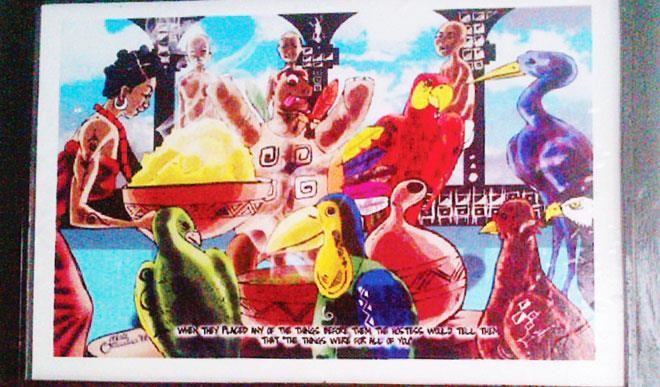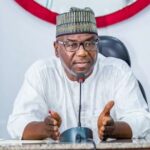
With careful and skillful strokes of their brushes and paints, two artists told, in their illustrations, the Igbo folktales in the two-weeks joint art exhibition on paintings, digital illustrations and drawings on Igbo folklore at the National Gallery of Arts, Enugu.
The artists, Muoneme Izuchukwu, a 2007 graduate of Fine and Applied Arts from the Nnamdi Azikiwe University (UniZik), Awka, Anambra State, who is also a staff of the National Gallery of Arts, Enugu and Chidiebere Oswald Onwuekwe, another 2007 graduate of Fine and Applied Arts from the same university, were participating in an exhibition tagged “Folkloric Expressions.”
The artists – Muoneme and Onwuekwe – had on display 20 and 18 works of paintings, respectively. While Muoneme’s works are comprised of paintings on mixed media, oil on canvass and ink-on-paper, Onwuekwe’s arts are digital illustrations and drawings. Both works focus on the Igbo folktales, especially as they concern the legendary tortoise and its tricky ways of undermining its fellow animals.
Muoneme has such works on exhibition as “Tortoise and the Birds,” (mixed media), “Mmiri a maa Umu Anumanu” (acrylic on canvass), “Igwebuike,” (water colour on paper), “Polygamous Family,” among others.
On the other hand, Onwuekwe has on display works such as “Ugani a daa!” (digital art), “Mbe Nwangiga na Umu nnunu,” (digital art), “The Flight,” (digital art), “Guests,” (digital art), “Greedy Mr. Tortoise,” (digital art), (digital art), etc.
Both artists used bright colours and animal forms to drive home their messages in the ordinary life of people in the old and contemporary Igbo society. Their works are full of folktales, myth, proverbs, parables, idioms, etc and both of them use one famous form of native African folklore which is the legendry, cunning, ‘master trickster’, the tortoise which in Igbo fairy tales, adopts native wisdom, wits, ancient diplomacy, tricks to survive in the midst of bigger, stronger and more vicious animals. The artists, in their stories, portray the belief system and attitudes of the Igbo people of the southeast Nigeria.
The theme of their works is carefully arranged in the same flow of the story line such that at the end the mischievous, greedy and tricky tortoise, who tries, though subtly, to lord it over the rest of the animals in the animal kingdom, is usually visited with the karmic law or retributive justice.
The exhibition is, in fact, an attempt to establish folklore as an important aesthetic trope in African art by re-inventing their methodology beyond ordinary understanding, explained Dr. Okechukwu Nwafor, senior lecturer and Head, Department of Fine and Applied Arts, Nnamdi Azikiwe University, (UniZik), Awka, Anambra State.
He said, “ They have injected sociological as well as historical factors into folkloric genre…Their art seems to emanate from a specific connectedness to oral culture and this, in my mind, intensifies the wild and rustic dynamic of their style.”
Muoneme told our reporter: “Over time, I discovered that people no longer appreciate the fact that Igbo folktales still have salient moral lessons to derive from them. So I decided to adopt them in my paintings.
“You can see from the different paintings I have on the exhibitions, whether it is mixed media, oil on canvass or ink-on-paper, it has to illustrate one or two Igbo folktales. So that’s my major inspiration and also the idea behind it is that what I want to achieve is to revive Igbo folktales; let the younger generation of Igbos start to appreciate the Igbo folktales again.
“Today, people are no longer having the zeal to read books. A lot of books have been written on Igbo folklore but a lot of people don’t even read such books again. But visual art is something that you can easily relate to even if you don’t have interest in it. Once you see it, at least, the aesthetic value will attract your attention. So that’s why we adopted it in our paintings so that we pass the message of Igbo folktales, and let people appreciate the fact that the Igbo have a culture and we have to preserve it. That’s what we are doing with this particular exhibition.”
Also in an interview, Onwuekwe, who teaches fine and applied arts at UniZik, Awka, said : “My works are digital illustrations. The reason is just to marry both traditional and modern; employing modern equipment in creating illustrations. It’s a little bit advanced because we are in the 21st century and a lot of technologies are in place and we need to employ them in creating those traditional values we used to have.”
He further explained: “Actually, folklore is Igbo tradition and Igbo value. It’s just to restore Igbo value in another dimension because I know that the culture of reading has depreciated a lot. But with visual art and visual metaphor of folklore, we intend to force people of today to view, to see that folkloric expressions in visual forms rather than asking them to read them.”
Earlier in his opening remarks, the curator of the National Gallery of Arts (NGA), Enugu, Mr. James Irabor lamented that the gallery was being underutilized but emphasized that by allowing the exhibition to hold at the NGA, “we want to make a point because we have always stressed that the NGA is a place for the education of arts; we have always advocated for people to come and utilize this place so that this environment will be known as a hub for the arts.”
Irabor told the audience: “There are people in the institutions of higher learning of arts who don’t even know that the National Gallery of Arts exists here.” He, however quickly added: “When Izuchukwu and Muoneme approached me to exhibit their works here, I encouraged them to do so. I was really happy when I saw the type of drawings and paintings they produced. They are trying to translate the stories they have created through their collection of works.”
Also, in his opening remarks before declaring open the exhibition, the special guest and chairman of the occasion, Dr. Okey Ikenegbu, Director, School of Arts, Institute of Management and Technology (IMT), Enugu said that man, naturally, is an artist.
“You’re being here this evening, shows your interest in arts,” he remarked.
Making reference to Chinua Achebe’s literary feat with his blockbuster novel, Dr. Ikenegbu said in 1958, a young Igbo boy, at the age of 28 published “Things Fall Apart,” in which he brought out in no other way the interest, passion of the era. It’s amazing that at such a young age, he was able to do that. What he did was to recreate the Igbo nation before the white man came,” recalled Ikenegbu, who added that “today, we have gathered here because of these two Igbo chaps who have thought it wise to bring to life the folklore of the Igbo nation. What they have done is good. In this era of our national self-definition, we are looking for what we are known for. The artists have thought it wise to look inwards and we are gathered here to look at the stories in drawings and paintings.”

 Join Daily Trust WhatsApp Community For Quick Access To News and Happenings Around You.
Join Daily Trust WhatsApp Community For Quick Access To News and Happenings Around You.


